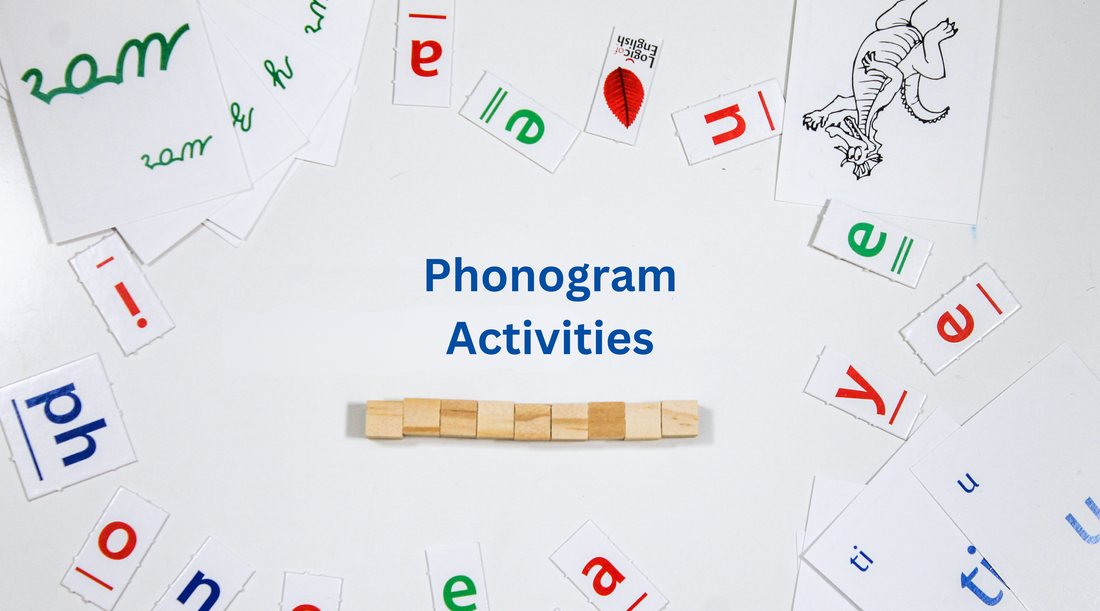Beyond the Drill: Fun and Creative Phonogram Practice at Home

Phonograms are the most basic and perhaps the most important component of the written English language. A combination of phono, meaning sound, and gram, meaning something written, the word “phonogram” most simply translates to sound put into writing. Phonograms are truly the building blocks of all written English words. Once students have mastered them, these phonograms – just like those little blocks at the bottom of your toy bin – can be put together in endless combinations as students read and write!

Whether you are a homeschooling family, a classroom teacher, or someone supporting classroom instruction from home, there is a good chance that at some point you’ll have a student who would benefit from some extra practice as they work to master the sounds of the phonograms, and we have good news:
Phonogram practice at home doesn’t take tons of prep time or require a closet full of supplies to be fun and engaging for both you and your student!
Flash cards can be a quick, simple, and effective way to practice phonogram sounds, but if we’re honest, that can get boring when it’s our only strategy. Younger and older students alike can benefit from additional phonogram practice that is playful and multimodal. (And as a bonus, you just might have some fun yourself!)
Phonogram Activity Ideas
If you’re looking for some fun ways to reinforce phonograms with your student, here are some easy and engaging ideas that anyone can try at home.

Phonogram Hopscotch
- Adjust the arrangement to meet your student’s needs: write a phonogram in one square for each sound it makes and say one sound per hop, or write a different phonogram in each box to review a larger number of phonograms.
- Use “spot dots” or tape for an indoor version: have students hop from spot to spot as they say the sounds of each phonogram.
Phonogram Name That Tune
Choose a phonogram with multiple sounds that you want to practice and hold up the phonogram flash card. Using only the sounds of that phonogram, sing the tune of a familiar song. Ask your student to guess the song. Then swap roles and ask your student to sing a song of their choice using only the sounds of the target phonogram.
- Make sure to have the phonogram on display as you sing the sounds to reinforce its connection to its sounds!
- Level up the challenge for your student by including a few “oldies!” (Are boy bands considered “oldies,” these days?)
Phonogram High-Five
Draw or print a simple hand outline. Write the phonogram you are practicing in the palm of the hand and tape it to a wall, doorframe, refrigerator, or other place your student walks by often. Every time you and your student pass the hand, give it a high five while saying the sounds of that phonogram!
- Post multiple handprints around the house to practice multiple phonograms.
- Laminate the handprints and write on them with wet-erase markers to practice different phonograms over time.
- Take the fun outside and use sidewalk chalk on a fence or brick wall!
Bowl-O-Gram
Prop up two or three phonogram cards against the wall and have students stand several feet away. Review the sounds of each phonogram displayed with your student. Then, as you name the sounds of one of the phonograms, your student will roll a ball toward that phonogram. If the student misses, they may re-roll the ball, repeating the sounds of that phonogram as they do.
- For extra challenge, consider using phonograms with similar sounds, such as OW, OU, and OUGH!
- For younger students, set up one phonogram at a time.
Simple Phonogram Race
Place the phonogram cards (flash cards or game cards) you’d like to review in a stack. Have your student(s) line up on one side of the room. Take turns naming the sound(s) of the next phonogram in the stack. For each correct sound, the student will take one step forward. (For example, a student could take one step for AI or five steps for OU.) Once you’ve gone through the cards in the stack, shuffle them and continue until someone reaches the other side of the room.
- Use cones to take this game outside and allow students to hop or leap for each sound!
- Use a blank board game template and small figurines to play this game at a table-top scale. (See the Phonogram Game Board on page 17 of our free Game Book Master Templates download)
Whether you are teaching your child from home or supporting classroom instruction, consistent practice with a playful approach can be a highly effective way for students to internalize phonogram knowledge that allows them to fully unlock the written English language. Use these ideas or come up with some of your own to make phonogram practice a blast for you and your students!
A Note for Classroom Instructors

If you are teaching in a classroom setting, partnering with families to reinforce phonograms from home is immensely valuable. Sharing some of these ideas with your families is a great place to start, and strong communication helps everyone work together! Here are some additional tips as you support families:
- Be sure to communicate regularly with all families about which phonograms
have been introduced in class. - For students who are struggling with particular phonograms, let families know which ones they can focus on at home to help their students succeed.
- Using our free Phonogram Mastery Chart to track each student’s progress at school and sending a copy home on a regular basis can be a clear and efficient way to do this! On the take-home copy, you may want to circle or highlight the phonograms you’d like each family to focus on with their practice at home.
For more ideas about how to use a playful approach to literacy skill development, check out the Logic of English Game Book. This easy-to-navigate book includes more than 300 games to practice phonograms, spelling rules, High-Frequency Words, and more!

